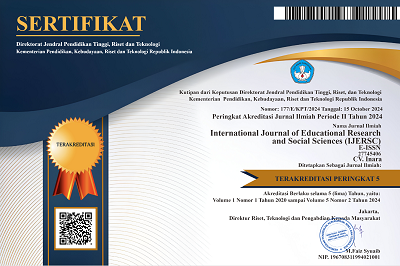Developing English Speaking Material For Students Of Business And Management Program At Vocational School
DOI:
10.51601/ijersc.v4i3.651Published:
2023-06-28Downloads
Abstract
The objective of this study was to develop English speaking material
based on students’ needs. This study followed the steps of research and
development proposed by Borg and Gall. Which are 1) evaluation and
need analysis; 2) material development; 3) validation; 4) revision and
final production. It was found that 83% students agreed that the existing
materials currently used by the students were irrelevant with business
and management program.The irrelevance materials were then
developed through CTL approach and relevant with their study program
and work life situation. The learning materials were developed into 6
units of speaking material. The learning materials were then validated
by two experts. The average score of the validation was 88, It showed
that learning materials were very good, relevant and feasible.
References
Anwar, Munash. 2007. English in Progress. Jakarta: Yudhistira
Brown, doughlas. 2001. Teaching by principles (an interaction approach to language pedagogy). New York:
Addison Wesley Longman.
Brumfit, Christopher. 1994. Communicative methodology in language teaching. New Castle: Althenaeum Press
Ltd, Newcastle Upon Tyne.
Dick and Carey. 2005. The systematic design of instruction. New York: Library of Congress Cataloging
Dickinson, Paul. 2010. Evaluating and adapting materials for young learners. Singapore: Longman Group.
Dirgeyasa, I Wy, 2011. The Study of Need Analysis of Tourism Topics and English Linguistics Features through
Local-based Needs at the Golden Triangle Tourism Destination in North Sumatra Province Indonesia. Asian
EFL Journal Issue 86. 8 (7)
Dini, Erika. 2015. Developing English Supplementary Speaking Materials Based on the Contextual Teaching
and Learning for The Tenth Grade Students of Senior High Schools. Yogyakarta: Yogyakarta State University
International Journal of Educational Research & Social Sciences ISSN: 2774-5406
Erawati, Fitri. 2015. Developing English Speaking Materials for Students of Culinary Study Program at
Vocational School through Task-Based Learning. Medan: State University of Medan.
Harmer, Jeremy. 2004. How to teach English. Kualalumpur: Pearson Education
Hutchinson, Tom. 2016. English for specific Purposes. Cambridge University Press
Irmayantia, Dian 2012. Developing english speaking learning materialsfor the personnel of small-scale craft
industries and department of industry, trade, and cooperatives in kebumen district. Yogyakarta: State university
of Yogyakarta
Kem, errold. 1997. Instructional design: a plan for unit and course development. New York: Library of
Congress Catalog
Kusuma. Parwakal. 2013. Developing an english speaking material for the grade eleven students of automotive
engineering at smk sanjaya ngawen in the academic year 2013 – 2014. Yogyakarta: state University of
Yogyakarta
Manurung, Konder. 2014. Improving the speaking skill using reading contextual internet-based instructional
materials in an EFL class in Indonesia. Journal of science direct. 3 (5)
Nunan, David. 2000. Second language teaching & learning. Canada: Heinle & Heinle
Tomlinson, Brian. 2013. Developing Materials for Language Teaching. Bloomsbury. Cambridge: Cambridge
University Press.
License
Copyright (c) 2023 International Journal of Educational Research and Social Sciences (IJERSC)

This work is licensed under a Creative Commons Attribution 4.0 International License.






